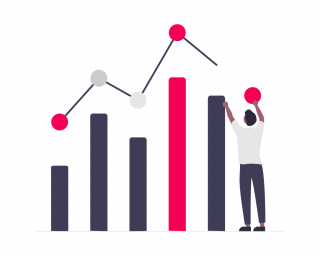
Hold on! I’m not saying you are sad. Neither am I, at least not perpetually. A while ago, I was, but that was because of some epic wrestle of upper-cut blows I kept conceding from one stubborn computer bug all day. My days of watching Rey Mysterio beat plus-sized opponents were not useless, so I broke its horns and gave it a graceful burial. Victory dance and drumrolls, anyone? Whoosh!
“Hmm, So what’s this happiness system thing?”
I suddenly reflected on James Clear’s concept of Creating Systems from his book Atomic Habits, in which he stresses systems as more realistic and practical in pursuing goals. From this idea, we go from My goal is to be happy to I want a system that recycles my happiness.
Think of this post as an extension that provides variables you can manipulate and slot into your habits for a happier living. Of course, it won’t be a utopian transition. Life will still suck sometimes. Ouch!
In the following paragraphs, I briefly explore the
- Chemistry of Happiness
- Hedonic Treadmill
- Climb, Gratitude & Mindfulness
Note that these will not be in-depth, so I will attach links for you to explore further. I’m basically giving you a headstart with this post.
CHEMISTRY OF HAPPINESS
Unless you skipped or slept through science class (I did, too), you should know that hormones and neuro-transmitters fundamentally trigger every emotion we feel. Stressed? Cortisol. In danger? Adrenaline. Achieved a goal? Dopamine. The question is, how do we hack our bodies to release chemicals that make us happy, or how do we create the natural conditions that boost them?
In his Why Leaders Eat Last presentation, Simon Sinek explains the 4 happy chemicals. Please watch the video for more context and explanation, but here is a summary.
Endorphins: the pain-masking chemical
Endorphins help us push through challenging circumstances, such as running, lifting weights, or workouts. Ironically, there is a pleasurable feeling in these moments of ‘pain’.
Sources of endorphins include
- Exercise
- Laughter (for example, watching comedy)
- Meditation
DOPAMINE : THE GOAL-ACHIEVING CHEMICAL
Dopamine is what propels us to get things done. However, dopamine can be dangerous when triggered by unhealthy sources such as constant social media use and gambling. How dopamine works is further explained here.
Examples of activities that help with healthy dopamine release include
- Enough Sleep
- Trying something new (exploring your creativity)
- Achieving a Goal
- Practising self-care
SEROTONIN
When we are admired and respected, it boosts our confidence and makes us feel amazing. This experience is what we get from Serotonin — feelings of pride and status.
Some sources
- Nature Walks
- Sun Exposure
- Healthy Diet
- Nature Walks
OXYTOCIN : THE CHEMICAL OF LOVE
Oxytocin is associated with the feelings we experience from physical touch and emotional bonds.
- Socializing
- Showing affection
- Helping Others
- Physical Touch (I know what your mind is thinking here,; you naughty kid 🌚)
HEDONIC TREADMILL
“Humans will return to a relatively stable level of happiness despite positive or negative life events.”
When something positive happens to you, and your lifestyle improves significantly, those changes will level out. You will get used to them and return to the same level of happiness you were before those changes.
Similarly, when you miss out on an opportunity that makes you sad, you will return to the previous level of happiness relatively quickly before any of that happened.
Think of the hedonic treadmill as a sine wave. No matter how high or lower you go, you return to the midline.
Here is how you can use the Hedonic Treadmill to your advantage for positive and negative scenarios
When positive things happen in your life
For example, if you make more money, distribute the spending over time. You will be much happier for longer if you use your money slowly over time like using the money to slowly upgrade your lifestyle.
So, Faddal, are you saying I shouldn’t buy that Macbook, iPhone and AirPods all at once but instead buy them one after the other bi-weekly so that I have something to look forward to every time? Yes! But I know you are impatient and probably won’t listen to me. It’s fine.
When negative things happen in your life
For example, when you go bankrupt and have to make lifestyle cuts, make the changes all at once so that it doesn’t prolong the suffering from that lifestyle change. The earlier you drop them, the quicker you return to that baseline of happiness before those changes. Think of a relationship breakup where you still try to hold on to your ex-partner. The more you hold on, the more the pain. However, when you cut off completely, you heal faster, although it’s still painful.
The Climb, Mindfulness & Gratitude
We are all familiar with the idea of enjoying the process instead of being frantic about the end goal. However, this is still difficult, given that the end goal is to alleviate or eradicate some kind of suffering. Alternately, there is still joy in the climb — the character-building, self-improvement, and all other activities involved make you better. Real-time awareness of these things will make you feel good.
Furthermore, practising mindfulness and gratitude makes us feel that at least we are not worse off. Contrasting our situations with scenarios in which we lack the current things we have makes us feel better. Some of my top gratitude points are Internet access, a roof over my head when its raining and the ability to have goals!
CONCLUSION
You create your happiness system by actively knitting these ideas into your habits to have a self-replenishing happiness tank. Here is James Clear’s habit guide to help you with that.
Gratitude and mindfulness have helped me in the past and still do, but I am looking forward to how I actively incorporate the hedonic treadmill and happy chemicals.
I hope you liked this!
REFERENCES
The Hedonic Treadmill Explained



